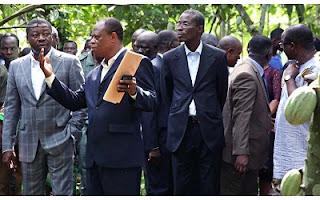Faure Gnassingbé visited the coffee-cocoa producers in Zogbegan, a locality in Wawa prefecture, mid-week. Objective, encourage them.
The person himself recalled this visit on his twitter account: "I went to the contact of the populations in Badou in the prefecture of Wawa. It was an opportunity to visit a cocoa plantation in Zogbegan and Azafi's plant material production center (CPMV).
The coffee-cocoa sector, for its revival, is financed by the World Bank, the European Union, among others.
And the competent authorities are counting on a production of 300,000 tons of coffee and 26,000 tons of cocoa for this year.

Comments
Post a Comment